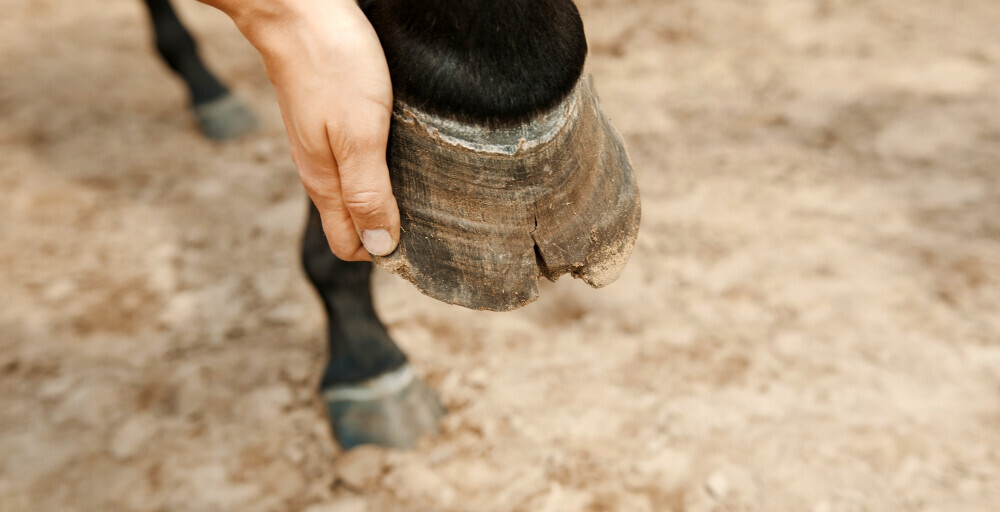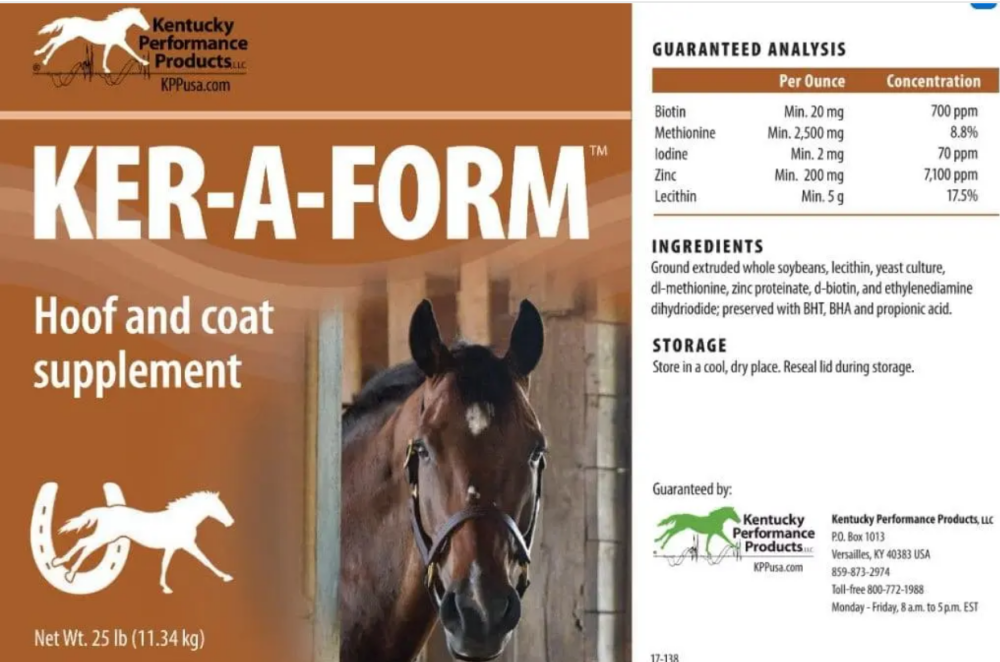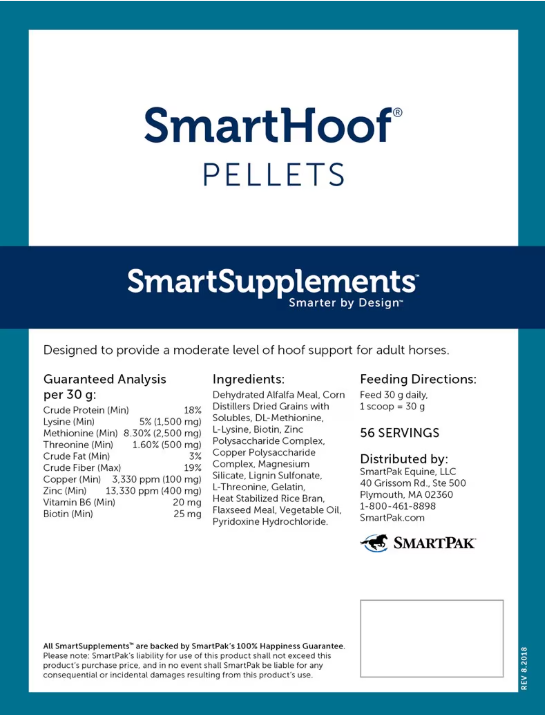
Brittle, cracked hooves aren’t just frustrating—they can lead to pain, lameness, and difficulty holding shoes. Good hoof health starts with a balanced diet and proper farrier care. But for horses prone to weak or crumbling hooves, targeted hoof supplements can be a game-changer.
I’ve reviewed the most trusted hoof supplements on the market—based on ingredients, real-world results, and user feedback. Not only have I used them myself, but I’ve researched what really works so you can make the best choice for your horse.
Some products stand out thanks to solid science and a reputation for results. But choosing the right one depends on your horse’s specific needs—whether that’s regrowth support, cracked wall prevention, or boosting hoof integrity year-round.
Top Hoof Strengthening Supplements Compared
Here’s a closer look at four of the most popular and effective hoof supplements trusted by horse owners:
- Farrier’s Formula Double Strength – by Life Data Labs
- KerAForm Hoof Supplement – by Kentucky Performance Products
- Grand Hoof Pellets – by Grand Meadows
- SmartHoof Pellets – by SmartPak
“Always consult your veterinarian or a qualified equine nutritionist before starting a hoof supplement, especially if your horse is on other fortified feeds or has metabolic issues.”
Farrier’s Formula Double Strength
Farrier’s Formula has been one of the most well-known supplements for hoof health for decades, and for good reason. I’ve personally seen dramatic improvements in horses on this formula—especially those with chips, cracks, or slow growth.
It delivers 20 mg of biotin per serving, along with key nutrients like DL-methionine, zinc, copper, omega fatty acids, and lecithin—supporting stronger hoof walls, healthier soles and frogs, and even coat condition.
This formula is especially effective for horses who need help with hoof strength and growth. The large pellets are palatable for most horses. Most horses show visible hoof improvements after 4–6 months, but remember: a full hoof wall takes 8–12 months to grow. Stick with your supplement and routine consistently to see long-term results.
- Form: Pellets
- Dose: ½ measuring cup (85g) daily per 1000 lbs of body weight
- Duration: 11 lb bag = 60 day supply for a 1000 lb horse
- Cost: $83.99 (~$1.40/day), $146.99 for 22 lb bucket (~$2.45/day)(prices are approximate)
- Ingredients: Alfalfa Meal, Soybean Hulls, Soy Protein Concentrate, Flaxseed, Lecithin, Yeast Culture, DL-Methionine, L-Threonine, Choline Chloride, Hydrolyzed Collagen, Hydrated Sodium Calcium Aluminosilicate, Biotin, Ascorbic Acid (Vitamin C), Zinc Oxide, Zinc Proteinate, Copper Chloride, Copper Proteinate, Manganese Sulfate, Manganese Proteinate, Iodized Casein, Calcium Iodate, Selenium Yeast, Dried Kelp, Fenugreek Extract, Natural and Artificial Flavors.
KerAForm Hoof Supplement

KerAForm comes from a trusted brand focused on research-backed nutrition. It’s especially popular with horse owners who want to improve both hoof and coat quality. KerAForm features a moderate biotin dose (20 mg per serving) and also includes methionine, lysine, and healthy fats from soybeans. The fatty acids are important for keeping hooves from becoming dry or brittle, which is a problem in dry climates or during winter months… but it also creates a barrier that repels excessive moisture.
Another bonus is that it promotes a glossy coat and healthy skin. That’s great if your horse tends to have dry or flaky skin, which often goes with hoof problems—or if you just want him looking top notch.
- Form: Powder
- Dose: 1 scoop = 1 oz.
Maintenance: 1 scoop daily
Extra support: 2 scoops daily - Duration: 3-lb = 48 days at 1 scoop/day
25-lb = 400 days at 1 scoop/day
- Cost: $210.47 ($0.53/day) for 25lb, $42.05 ($0.88/day) for 3lb (approximate)
- Ingredients: Ground Extruded Whole Soybeans, Lecithin, Yeast Culture, DL-Methionine, Zinc Proteinate, D-Biotin, Ethylenediamine dihydroiodide (EDDI)

I have not used SmartHoof Pellets personally, but I’m genuinely impressed by the company’s reputation, customer service, and ingredient transparency. Based on overwhelmingly positive reviews, I’ve ordered SmartPak for my own horses to evaluate its long-term benefits.
This supplement includes 25 mg of biotin per serving—among the highest in this comparison—plus key nutrients like methionine, lysine, copper, zinc, fatty acids, and threonine. It also features hydrolyzed collagen, which may support joint health and cartilage resilience, particularly in older or performance horses.

- Pellet
- Dose: 1 scoop is equivalent to 30 grams.
- Duration: 3.8-lb Bucket (56-day supply), 7.6-lb Bucket (112-day supply), 15.2-lb Bucket (224-day supply)
- Cost: $55.74 ($1.00/day), $105.21 ($0.94/day), $194.68 ($0.87/day) (approximate)
- Ingredients: Alfalfa Meal, Corn Distillers Dried Grains, DL-Methionine, L-Lysine, Biotin, Zinc Polysaccharide Complex, Copper Polysaccharide Complex, Magnesium Silicate, Lignin Sulfonate, L-Threonine, Gelatin, Rice Bran, Ground Flaxseed (Linseed), Vegetable Oil, Pyridoxine Hydrochloride (Vitamin B6)
Not every horse needs the same supplement, so I always check for key features before choosing one. The most important nutrients are biotin (for hoof horn production), methionine and lysine (amino acids for protein synthesis), and trace minerals like zinc and copper.
Clear labeling, positive reviews from other owners, and science-backed brands help me feel confident in a supplement. I stick to well-known options with consistent ingredient quality and a track record of results. I sometimes try newer products, but only after reviewing solid feedback and studies.
| Nutrient | Farrier’s Formula | KerAForm | GrandHoof | SmartHoof |
|---|---|---|---|---|
| Biotin | 20.05 mg | 19.84 mg | 20 mg | 25.00 mg |
| Methionine | 5.30 g | 2.50 g | 3 g | 2.49 g |
| Zinc | 249.90 mg | 201.28 mg | 250 mg | 405.00 mg |
| Copper | 91.80 mg | — | 50 mg | 112.50 mg |
| Calcium | 0.47 g | — | — | — |
| Phosphorus | 0.70 g | — | — | — |
| Sodium | 0.43 g | — | — | — |
| Protein | 21.25 g | 28.07 g | — | 6.60 g |
| Lysine | 1.00 g | — | — | 1.50 g |
| Threonine | 0.68 g | — | — | 0.48 g |
| MSM | — | — | 5 g | — |
| Vitamin B6 | — | — | 20 mg | 20 mg |
| Other Key Ingredients | Yeast, Vitamin C, Omega 3, Phenylalanine | Yeast, Omega 3, Soybean meal | Diamond V Yeast | Gelatin, Hydrolyzed Collagen, Omega 3, Ground Flaxseed. |
- Farrier’s Formula: Highly recommended for long-term hoof issues like cracks and brittle walls. Many say it’s the only supplement that made a real difference—also benefits mane and coat.
- KerAForm: Known for improving both hooves and coat. Popular with owners who want better hoof wall integrity and fewer lost shoes.
- Grand Hoof: Reliable for consistent hoof improvement. Easy to feed, and owners report fewer lost shoes and improved hoof strength.
- SmartHoof Pellets: Noted for strengthening hooves and supporting growth. Picky eaters usually accept the pellet form well.
All four are trusted brands with loyal users. Picking the right one often depends on your horse’s taste, feeding preferences, and budget.
My own horses have had brittle hooves. I look for a supplement that’s easy to feed, well-reviewed, and recommended by professionals. I combine it with regular trimming, balanced nutrition, and patience—results often take 3 to 6 months.
- If my horse refuses powders, I pick a pellet option instead.
- For hooves *and* a shiny coat, I choose KerAForm or Farrier’s Formula.
- On a budget, I compare cost per dose—KerAForm and GrandHoof often offer the best value.
I always talk with my farrier or veterinarian before starting a new supplement to rule out underlying hoof conditions. Supplements help most when paired with expert care.
Consistency is key. I feed supplements daily and maintain a routine of good trimming and balanced nutrition to support long-term hoof health.
Frequently Asked Questions
How long does it take to see improvement in hooves?
Visible improvements typically take 3–6 months, depending on hoof growth rate. Some horses may take up to a year to show full results.
Can I feed more than one hoof supplement?
It’s not recommended. Over-supplementation of biotin, zinc, and copper can lead to toxicity or nutritional imbalance. Choose one balanced product.
Is biotin alone enough?
No. Biotin works best when paired with amino acids (like methionine), zinc, copper, and omega-3s to support keratin production and anti-inflammatory pathways.
Should I stop supplementing once the hooves improve?
Continued supplementation may be necessary if your horse’s base diet is deficient. Discontinue only if advised by a veterinarian or equine nutritionist.
Final Thoughts
Hoof health is about consistency and balance. While no supplement replaces good farrier care and a balanced forage-based diet, the right one can support stronger growth, fewer cracks, and greater hoof elasticity. Choose a product with clinical support and nutrient synergy—not just the highest biotin number.
📌 Disclaimer: This article is for educational purposes and does not replace veterinary advice. Always consult your vet or a certified equine nutritionist before starting a new supplement—especially if your horse has special health needs or is on other fortified feeds.
References:
Kempson SA. Ultrastructural observation on the response of equine hoof defects to dietary supplementation with Farrier’s Formula. Vet Rec. 1990 Nov 17;127(20):494-8. PMID: 2275088.
Camacho-Luna, P., Andrews, F.M., Keowen, M.L., Garza, F., Jr, Liu, C.-.-C., Lamp, B. and Olijve, J. (2022), The effect of porcine hydrolysed collagen on gastric ulcer scores, gastric juice pH, gastrin and amino acid concentrations in horses. Equine Vet Educ, 34: 248-257. https://doi.org/10.1111/eve.13409
Coenen M, Appelt K, Niemeyer A, Vervuert I. Study of gelatin supplemented diet on amino acid homeostasis in the horse. Equine Vet J Suppl. 2006 Aug;(36):606-10. doi: 10.1111/j.2042-3306.2006.tb05612.x. PMID: 17402491.
Graham PM, Ott EA, Brendemuhl JH, TenBroeck SH. “The effect of supplemental lysine and threonine on growth and development of yearling horses.” J Anim Sci. 1994 Feb;72(2):380-6
Hansen RA, Savage CJ, Reidlinger K, Traub-Dargatz JL, Ogilvie GK, Mitchell D, Fettman MJ. Effects of dietary flaxseed oil supplementation on equine plasma fatty acid concentrations and whole blood platelet aggregation. J Vet Intern Med. 2002 Jul-Aug;16(4):457-63. doi: 10.1892/0891-6640(2002)016<0457>2.3.co;2. PMID: 12141309.
Hess, Tanja & Ross-Jones, Trinette. “Omega-3 fatty acid supplementation in horses.” Revista Brasileira de Zootecnia (2014). 43. 677-683. 10.1590/S1516-35982014001200008.